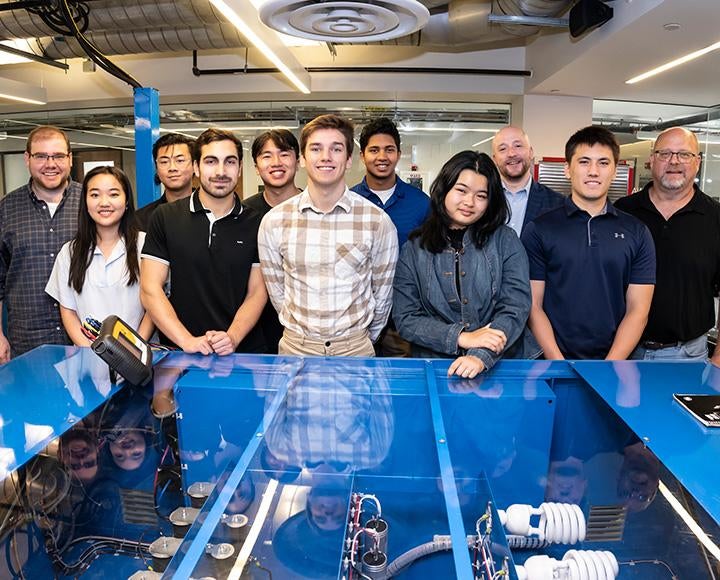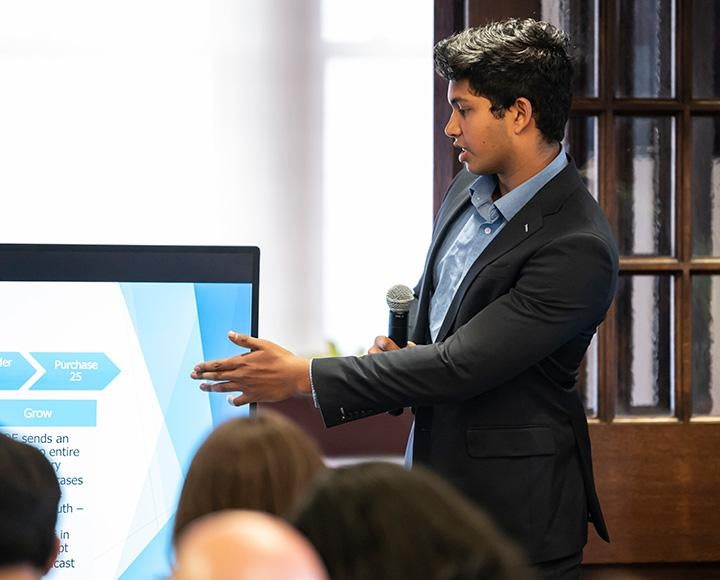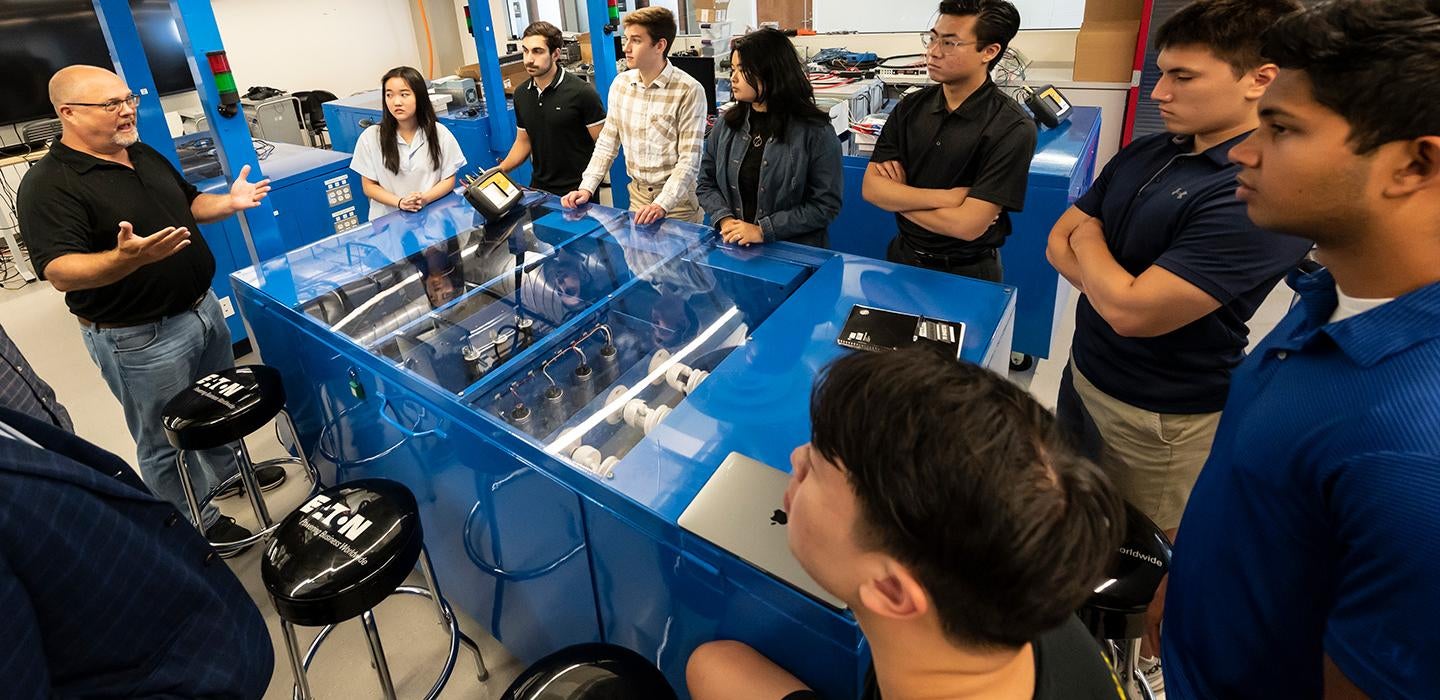
Subscribe to Pittwire Today
Get the most interesting and important stories from the University of Pittsburgh.Isabella Hsia, a rising sophomore in bioengineering at the University of Pittsburgh Swanson School of Engineering, wanted to try something new.
Maybe something a little more research heavy, she thought. Definitely something to diversify my skill set. But what about my talents as a future engineer?
As her first year in engineering ended, she couldn’t find the perfect program or internship to scratch her inquisitive itch.
“I really had no real-world experience up until this point,” Hsia said. “How do you know what you want to do after leaving Pitt if you haven’t tried anything apart from your classes?”
Then, an email from Brett Say, Pitt’s Director of Honors Research Programs, landed in her inbox, proposing an interesting opportunity. It was an invitation for students to participate in a pilot interdisciplinary program, Summer Honors Undergraduate Research Experience in Electric Grid, or SHURE-Grid, supported by the Idaho National Laboratory (INL). As a collaboration between Pitt’s Swanson School, David C. Frederick Honors College and Office of Research, SHURE-Grid provides students with experience solving real-world problems while engaging with one of the 17 national U.S. Department of Energy labs.
Hsia didn’t know anything about the electric grid, but she couldn’t pass up the opportunity to try something so unique. So, she, along with seven other Pitt students from various disciplines, signed up.
Preventing a total blackout
The program’s first objective is to define the power grid and why it’s so critical to the country.
The energy grid represents the infrastructure to generate, transmit and distribute electricity from the utility to the consumer across the U.S. The grid makes modern human life possible, but it is getting older and buffeted by the effects of climate change. New-end technologies like EVs and smart devices need more energy; at the same time, the inexorable shift from fossil fuels to renewables requires new technologies to both meet demand and ensure national security.
SHURE-Grid faculty advisors Brandon Grainger and Paul Ohodnicki, who established the Energy GRID Institute at Pitt, are well-versed in the possible weaknesses of the electric grid.
“As the grid is being transformed with more intelligence through digital means, it is becoming more vulnerable to cyberattacks,” said Grainger. “If hackers are able to get into these digital platforms, disruption to electricity flow can occur, including the worst-case scenario — a total blackout.”
Grainger, who is an associate professor of electrical and computer engineering and Eaton Faculty Fellow, and Ohodnicki, an associate professor of mechanical engineering and materials science, develop new grid technologies at the Energy Innovation Center in Pittsburgh’s Lower Hill District. They bring their expertise to developing the SHURE-Grid program to train the next generation in how to prevent a coming crisis.


Bridging information technology and engineering
There’s currently a debate in government, industry and utilities on how to best — and who can best — protect the electric grid. That’s where Pitt students come in.
Daniel Cole, associate professor of mechanical engineering and materials science at the Swanson School and classroom professor with Grainger for the SHURE-Grid program, explained that students were divided into two teams and given a real-life problem rooted in cyber-informed engineering (CIE) from INL to solve.
CIE, developed by the Department of Energy in June 2022, is a framework that bridges the gap between engineers and information technicians to protect the grid from cyberattacks.
Cole said the risks of cybersecurity to critical infrastructure like the grid are causing the engineering and information technology worlds to collide. But these two fields are totally different in methodologies and solutions. That’s where CIE comes in.
“CIE is intended to get engineers to think about things more cyber-related early in the process of designing,” Cole said. “Are there ways we can engineer the system to be more safe, secure and reliable?”
INL has been working with Pitt on CIE measures for more than a year. Ginger Wright, energy cybersecurity portfolio manager for INL’s cybercore division, proposed asking students to investigate and solve this growing divide between engineers and information technology.
She said it’s not just a beneficial program for the students, but an important opportunity for INL.
“When I learned about the potential of the SHURE-Grid program, it became clear students were capable of creating new methods for existing work at INL,” Wright said. “We wanted to leverage this program to teach students about CIE, but grant them the ability to interview stakeholders and make recommendations we may not have thought about.”
Two teams. One problem.
The two teams, called Team GPT and Cyber Informed Engineering Enthusiasts, are positioned to learn how companies are implementing and using CIE, whether it’s working and how to improve it.
“It’s not a class I would normally take,” said Kameren Jouhal, a rising sophomore from Montgomery County, Pennsylvania, who’s studying computer science. “It’s been really helpful for me, from networking to presenting.”
The method of solving these problems is simple: ask as many stakeholders as many questions as possible. The answers, however, aren’t quite as straightforward. Students need to continuously adapt their hypotheses and solutions to the problems at hand.
Every week, students present their findings to Cole and Grainger, who are intentionally highly critical of their presentations. This is part of the program’s learning process: The students have become more composed during these sometimes-intense moments and quicker to respond with well-researched answers.
There is occasionally well-meaning tension among students as they work through their projects, which they treat as a full-time job that requires multiple meetings and constant communication with each other. Say, the director of Honors Research Programs, was also able to secure apartments for some students in Bouquet Gardens for more convenient campus housing. Bioengineering sophomore Hsia said working with her team, made up of students from schools across campus, is one of the best learning experiences she’s had at Pitt.
“One of my teammates studies finance, so anytime I develop a solution, she has a million different questions for me that I didn’t even think of,” Hsia said. “It’s just part of the process.”
Rob Cunningham, vice chancellor for research infrastructure at Pitt, said SHURE-Grid is intentionally designed for students to interact with real industry professionals and a diverse group.
“Important results come from brilliant people with a wide range of backgrounds,” Cunningham explained. “Part of my job is working with multiple experts outside of mine and others’ realms, but all of them are working together to solve problems they find interesting and important. We wanted to have a program where Pitt undergraduates learned and experienced how true science is done, regardless of their degree and career path.”
Say also helped facilitate meetings and professional workshops between the SHURE-Grid program and the much larger Brackenridge Summer Research Fellowship Program.
Wright said although INL may not implement the solutions the students developed, these conversations will move the laboratory forward and, hopefully, be the start of many more student-led workshops and summer camps in the future.
“These solutions will be at least in our conversations,” Wright said. “They’ve built awareness for those in our industry and put these ideas out for us to consider.”
— Kat Procyk, photography by Aimee Obidzinski


